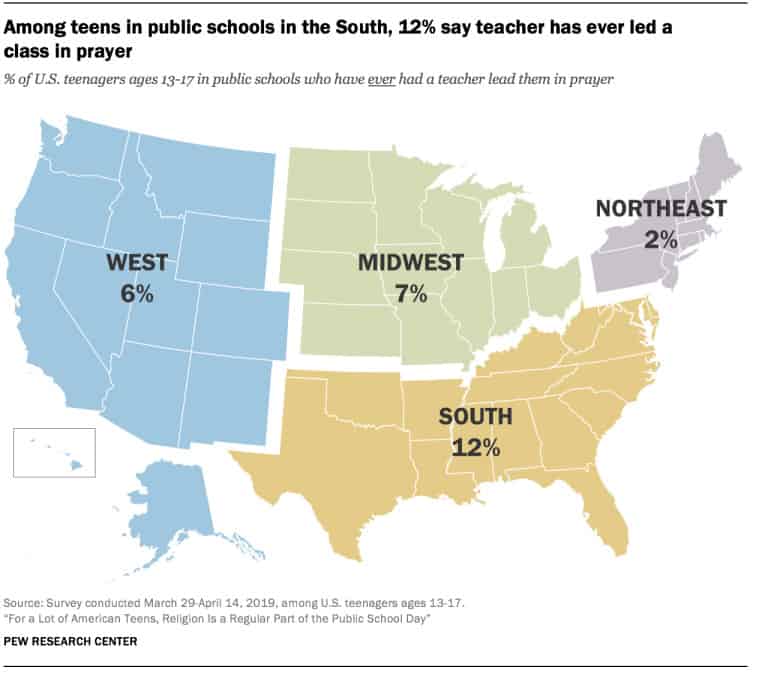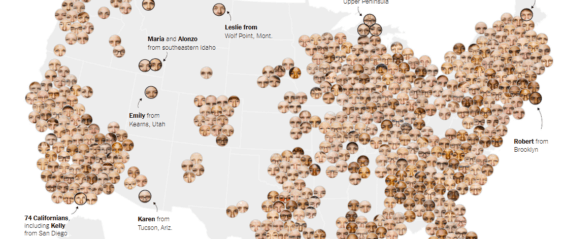For Your Consideration
There are roughly 19 million American households without access to broadband. This article from Brookings focuses on the digital divide at the state level by using American Community Survey 1-year data to judge state broadband performance and how those trends can inform future policy design.
In researching what drives broadband adoption differences between states, researchers found that states with higher median incomes, higher rates of education, fewer residents of color, and smaller rural populations had higher overall broadband adoption rates. The authors of the post suggest that these variables can inform policy design — such as prioritizing digital literacy programming in states with lower rates of education or addressing affordability in states with higher shares of low-income residents.
 A recent study from Pew Research considers the day-to-day experiences of religion in public schools across the country. The survey asked more than 1,800 teenagers (ages 13 to 17) about the kinds of religious activity they engage in – or see other students engaging in – during the course of the school day. Here are a few key takeaways:
A recent study from Pew Research considers the day-to-day experiences of religion in public schools across the country. The survey asked more than 1,800 teenagers (ages 13 to 17) about the kinds of religious activity they engage in – or see other students engaging in – during the course of the school day. Here are a few key takeaways:
- Among teens in public schools in the South, 12% say a teacher has ever led a class in prayer. This is an action that that the courts have ruled is a violation of the Establishment Clause of the Constitution. And, 13% of teens in public schools in the South say a teacher has read to them from the Bible as literature.
- Most American teens (64%) say they rarely or never discuss religion with their friends, and only 5% say they often engage in such discussions.
- Four-in-ten teens who attend public schools say they commonly (either “often” or “sometimes”) see other students praying before sporting events at school.

Making News
In this piece in the Wall Street Journal, Dhruv Khullar, a physician and assistant professor of Medicine and Healthcare Policy at Weill Cornell, and director of policy dissemination at the Physicians Foundation Center for Physician Practice and Leadership, explores what happens when new supermarkets open in food deserts.
Khullar cites a recent study that examined thousands of new supermarket openings across the country and found that less than one-tenth of the nutritional inequality between high- and low-income households could be explained by the availability of healthy foods. The other 90% was due to differences in demand. Thus, introducing a supermarket into a food desert is not likely to change the grocery habits of nearby residents.
Khullar concludes that “food deserts don’t cause obesity” — but says that eliminating food deserts “may still be part of a broader shift toward greater food security today and a healthier food environment and population in the long run.”
Need to Know
We are pausing Friday@Five for the next two weeks while my colleague Molly Osborne is out for her wedding. She’ll be back in your inbox on November 1st. Congratulations, Molly!
What we're reading
These 526 Voters Represent All of America. And They Spent a Weekend Together.
What would "America in One Room" look like? A nonpartisan group named Helena raised $3 million to fly 526 voters to a hotel in Texas where they debated foreign policy, health care, immigration, the economy, and more.... Read the rest-
Waste gobbles up 25% of US healthcare spending, JAMA study finds
-
Forging connections across the Carolinas – one greenway, trail and waterway at a time
-
San Francisco’s False Solution
-
How Governors Are Shaping the Opportunity Zone Landscape
-
Some colleges seek radical solutions to survive
-
More States Say Goodbye to Columbus Day


